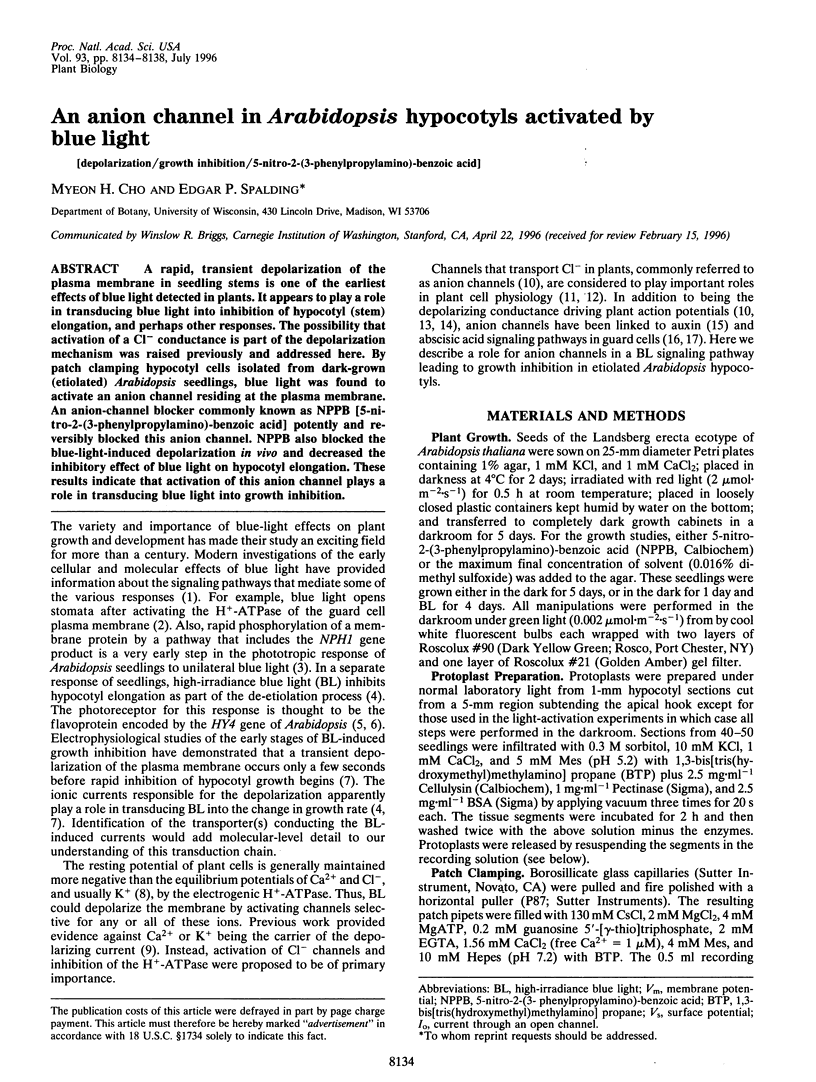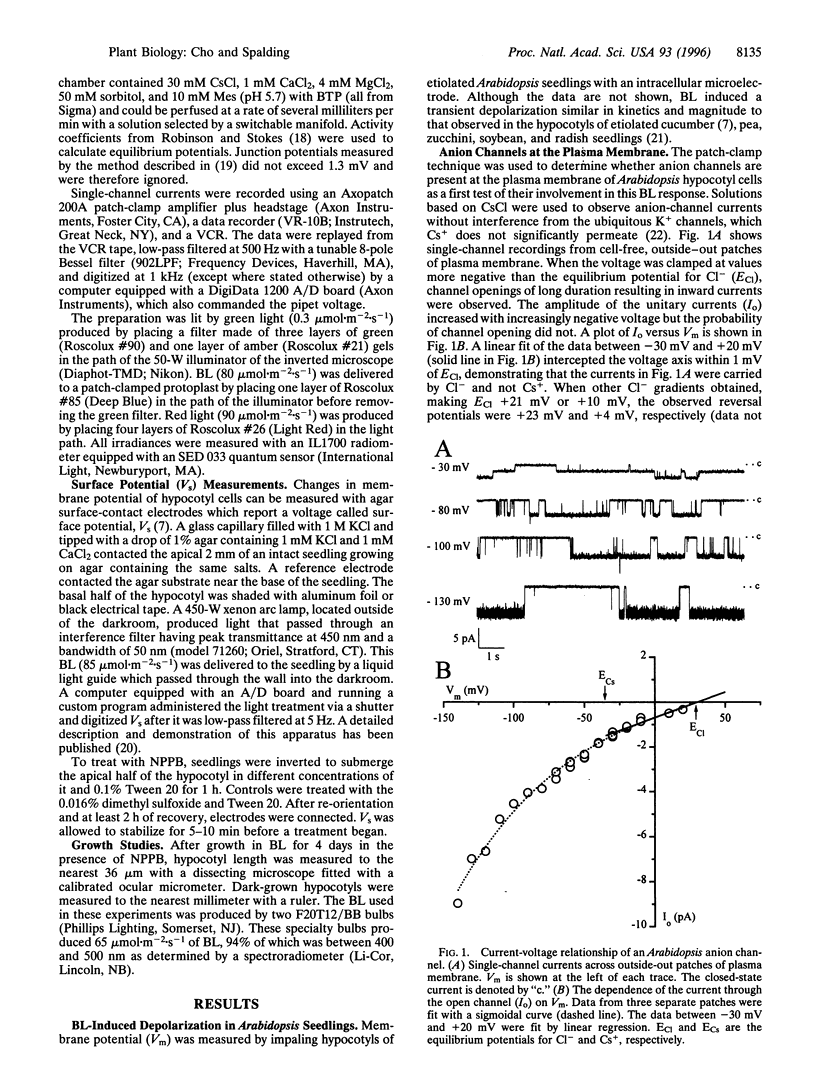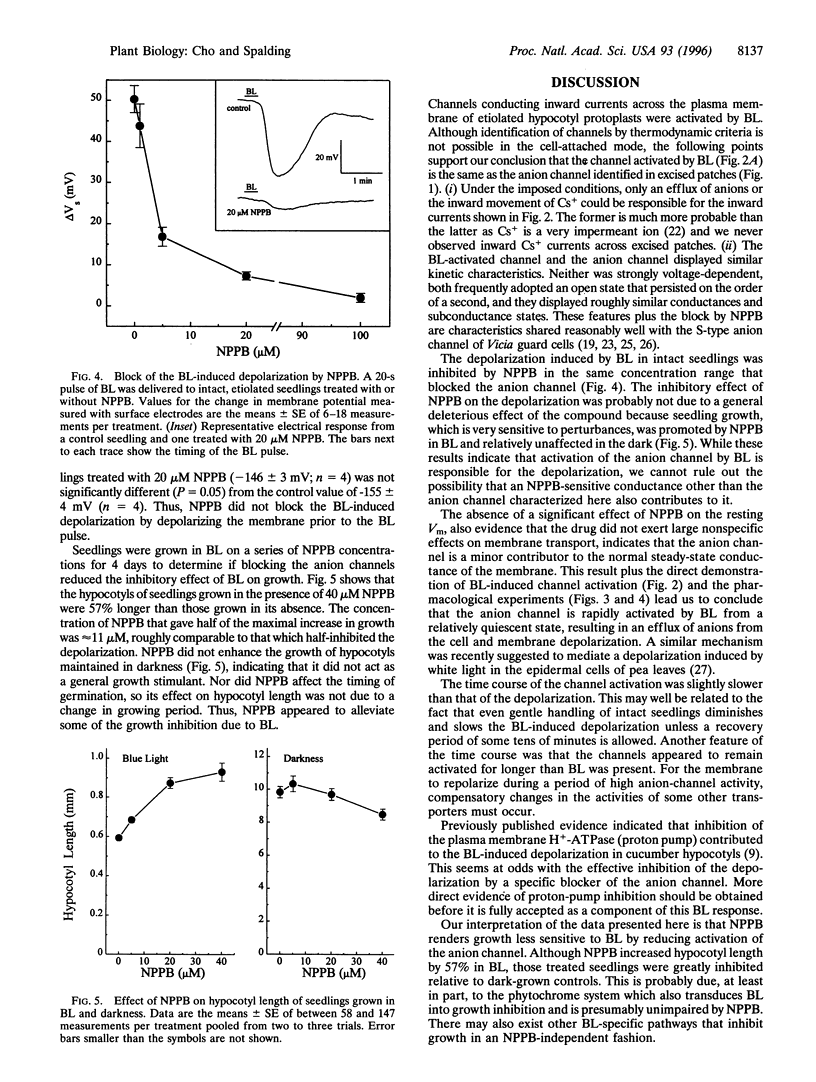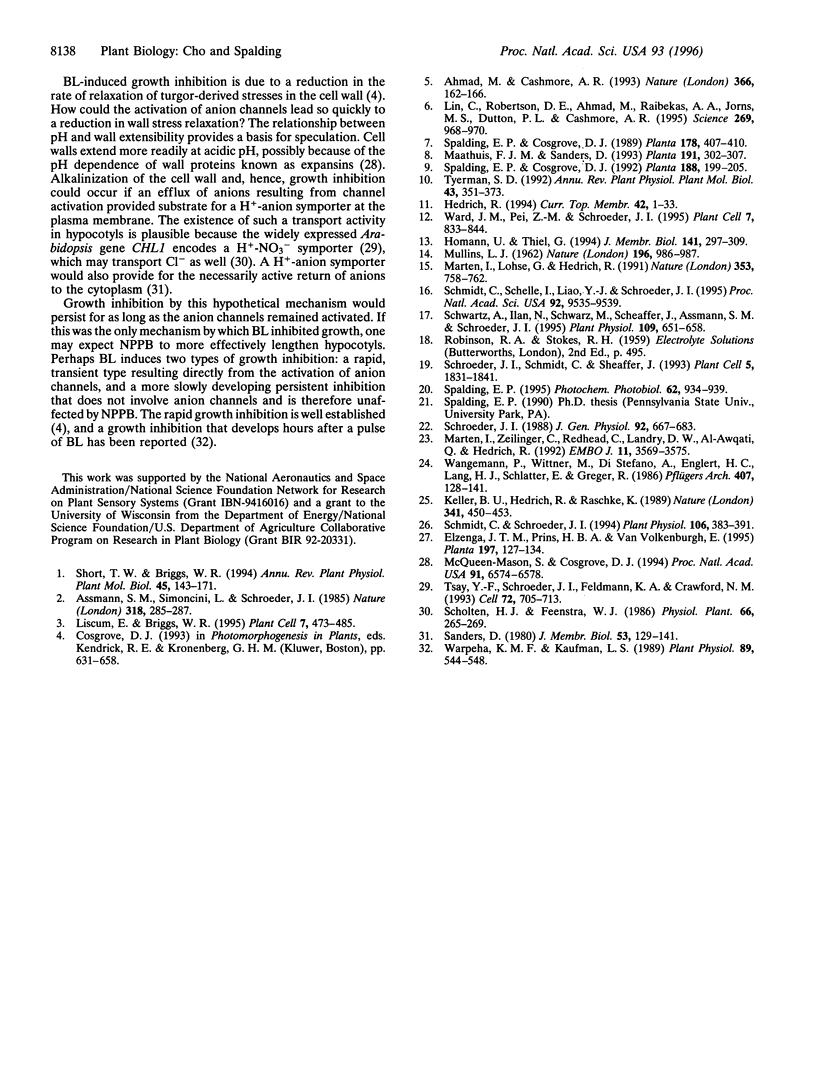Abstract
A rapid, transient depolarization of the plasma membrane in seedling stems is one of the earliest effects of blue light detected in plants. It appears to play a role in transducing blue light into inhibition of hypocotyl (stem) elongation, and perhaps other responses. The possibility that activation of a Cl- conductance is part of the depolarization mechanism was raised previously and addressed here. By patch clamping hypocotyl cells isolated from dark-grown (etiolated) Arabidopsis seedlings, blue light was found to activate an anion channel residing at the plasma membrane. An anion-channel blocker commonly known as NPPB 15-nitro-2-(3-phenylpropylamino)-benzoic acid] potently and reversibly blocked this anion channel. NPPB also blocked the blue-light-induced depolarization in vivo and decreased the inhibitory effect of blue light on hypocotyl elongation. These results indicate that activation of this anion channel plays a role in transducing blue light into growth inhibition.
Full text
PDF




Selected References
These references are in PubMed. This may not be the complete list of references from this article.
- Ahmad M., Cashmore A. R. HY4 gene of A. thaliana encodes a protein with characteristics of a blue-light photoreceptor. Nature. 1993 Nov 11;366(6451):162–166. doi: 10.1038/366162a0. [DOI] [PubMed] [Google Scholar]
- Homann U., Thiel G. Cl- and K+ channel currents during the action potential in Chara. Simultaneous recording of membrane voltage and patch currents. J Membr Biol. 1994 Sep;141(3):297–309. doi: 10.1007/BF00235139. [DOI] [PubMed] [Google Scholar]
- Lin C., Robertson D. E., Ahmad M., Raibekas A. A., Jorns M. S., Dutton P. L., Cashmore A. R. Association of flavin adenine dinucleotide with the Arabidopsis blue light receptor CRY1. Science. 1995 Aug 18;269(5226):968–970. doi: 10.1126/science.7638620. [DOI] [PubMed] [Google Scholar]
- Liscum E., Briggs W. R. Mutations in the NPH1 locus of Arabidopsis disrupt the perception of phototropic stimuli. Plant Cell. 1995 Apr;7(4):473–485. doi: 10.1105/tpc.7.4.473. [DOI] [PMC free article] [PubMed] [Google Scholar]
- MULLINS L. J. Efflux of chloride ions during the action potential of Nitella. Nature. 1962 Dec 8;196:986–987. doi: 10.1038/196986a0. [DOI] [PubMed] [Google Scholar]
- Marten I., Zeilinger C., Redhead C., Landry D. W., al-Awqati Q., Hedrich R. Identification and modulation of a voltage-dependent anion channel in the plasma membrane of guard cells by high-affinity ligands. EMBO J. 1992 Oct;11(10):3569–3575. doi: 10.1002/j.1460-2075.1992.tb05440.x. [DOI] [PMC free article] [PubMed] [Google Scholar]
- McQueen-Mason S., Cosgrove D. J. Disruption of hydrogen bonding between plant cell wall polymers by proteins that induce wall extension. Proc Natl Acad Sci U S A. 1994 Jul 5;91(14):6574–6578. doi: 10.1073/pnas.91.14.6574. [DOI] [PMC free article] [PubMed] [Google Scholar]
- Schmidt C., Schelle I., Liao Y. J., Schroeder J. I. Strong regulation of slow anion channels and abscisic acid signaling in guard cells by phosphorylation and dephosphorylation events. Proc Natl Acad Sci U S A. 1995 Oct 10;92(21):9535–9539. doi: 10.1073/pnas.92.21.9535. [DOI] [PMC free article] [PubMed] [Google Scholar]
- Schmidt C., Schroeder J. I. Anion Selectivity of Slow Anion Channels in the Plasma Membrane of Guard Cells (Large Nitrate Permeability). Plant Physiol. 1994 Sep;106(1):383–391. doi: 10.1104/pp.106.1.383. [DOI] [PMC free article] [PubMed] [Google Scholar]
- Schroeder J. I. K+ transport properties of K+ channels in the plasma membrane of Vicia faba guard cells. J Gen Physiol. 1988 Nov;92(5):667–683. doi: 10.1085/jgp.92.5.667. [DOI] [PMC free article] [PubMed] [Google Scholar]
- Schroeder J. I., Schmidt C., Sheaffer J. Identification of High-Affinity Slow Anion Channel Blockers and Evidence for Stomatal Regulation by Slow Anion Channels in Guard Cells. Plant Cell. 1993 Dec;5(12):1831–1841. doi: 10.1105/tpc.5.12.1831. [DOI] [PMC free article] [PubMed] [Google Scholar]
- Schwartz A., Ilan N., Schwarz M., Scheaffer J., Assmann S. M., Schroeder J. I. Anion-Channel Blockers Inhibit S-Type Anion Channels and Abscisic Acid Responses in Guard Cells. Plant Physiol. 1995 Oct;109(2):651–658. doi: 10.1104/pp.109.2.651. [DOI] [PMC free article] [PubMed] [Google Scholar]
- Spalding E. P. An apparatus for studying rapid electrophysiological responses to light demonstrated on Arabidopsis leaves. Photochem Photobiol. 1995 Nov;62(5):934–939. doi: 10.1111/j.1751-1097.1995.tb09159.x. [DOI] [PubMed] [Google Scholar]
- Spalding E. P., Cosgrove D. J. Large plasma-membrane depolarization precedes rapid blue-light-induced growth inhibition in cucumber. Planta. 1989;178:407–410. [PubMed] [Google Scholar]
- Spalding E. P., Cosgrove D. J. Mechanism of blue-light-induced plasma-membrane depolarization in etiolated cucumber hypocotyls. Planta. 1992 Sep;188(2):199–205. doi: 10.1007/BF00216814. [DOI] [PubMed] [Google Scholar]
- Tsay Y. F., Schroeder J. I., Feldmann K. A., Crawford N. M. The herbicide sensitivity gene CHL1 of Arabidopsis encodes a nitrate-inducible nitrate transporter. Cell. 1993 Mar 12;72(5):705–713. doi: 10.1016/0092-8674(93)90399-b. [DOI] [PubMed] [Google Scholar]
- Ward J. M., Pei Z. M., Schroeder J. I. Roles of Ion Channels in Initiation of Signal Transduction in Higher Plants. Plant Cell. 1995 Jul;7(7):833–844. doi: 10.1105/tpc.7.7.833. [DOI] [PMC free article] [PubMed] [Google Scholar]
- Warpeha K. M., Kaufman L. S. Blue-Light Regulation of Epicotyl Elongation in Pisum sativum. Plant Physiol. 1989 Feb;89(2):544–548. doi: 10.1104/pp.89.2.544. [DOI] [PMC free article] [PubMed] [Google Scholar]


